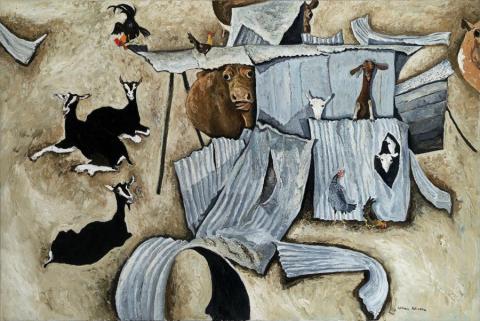FARMYARD, 1982
WILLIAM ROBINSON
oil on canvas
124.5 x 186.0 cm
signed lower right: William Robinson
Ray Hughes Gallery, Brisbane
Institutional collection, Sydney, acquired 1982
William Robinson: Paintings, Ray Hughes Gallery, Brisbane, 10-23 September 1982
Hammond, V., 'William Robinson: the viewfinder', Art and Australia, vol. 37, no. 4, 2000, p. 542 (illus., as 'Untitled, 1984')
William, Josephine and others, 1982-83, oil on canvas, 122.0 x 183.5 cm, Collection of Queensland University of Technology, Brisbane
William Robinson's place in the canon of Australian landscape painting is secure. Apart from regular forays into the Archibald Prize, which he won in 1987 and 1995, his subject has been his immediate environment; domestic interiors, his family hobby farm and on to the greater landscape of his native south east Queensland.
The Farmyards, as they are known, represented a departure for Robinson from his earlier formative work. The Bonnard inspired interiors which he exhibited in Brisbane through the 1970's gave way to this new body of work, Farmyard Constructions. The paintings took on an inspired urgency and became the subject of several solo exhibitions at Brisbane's Ray Hughes Gallery between 1978 and 1985. The works were eagerly acquired by a loyal coterie of collectors who seemingly had been in wait for such a development in Robinson's work. Two works from this period In the House Yard, 1985 and Dawn, 1986 were purchased by the Metropolitan Museum of Art, New York, and this added to interest in the artist which by now was growing quickly.
The Farmyard paintings offer a fascinating insight into the artist's development. The twisting and distorting of the forms hint at what was to come - even a goat's ability to climb and stand atop the farmyard detritus introduces the notion of contrary compositional structures. Similarly when the dams or waterholes first appeared in Robinson farmyard paintings, through the reflection of the surrounding animals, trees and clouds the water became the pictorial device that allowed Robinson to break from the convention of the horizontal horizon and move it to any part of the picture plane.
In these paintings Robinson quietly and meticulously developed his unique perspective on the landscape. In many ways the farmyards are closer to the still life genre than landscape, because the artist is able to treat the subject as he would a still life by arranging and rearranging the elements according to his intuition. The ground becomes the table top and the cows, goats and chooks take the place of traditional still life elements.
'It could be almost an arrangement of bottles or apples on a plate; the same sort of systems and rules apply. One of the interesting things that I developed while drawing and painting interiors prior to these works was my use of the frame's edge - I would have things just coming in or just going out of the picture frame. These pictures gave me great scope for that - things coming in, or coming down and moving in one way or another.'1
This major work is a quintessential example of Robinson's seminal farmyard paintings - substantial, experimental, and crucial to the development of Robinson's oeuvre. As the artist says, 'I find these paintings terribly interesting now, but in a way they shouldn't have ever been because they're so unlikely. I suppose I was experimenting at this point with the reality of thick paint. It is something that a photograph can never really capture - substance. Substance is important in a painting.'2
1. Robinson, W., The Farmyards, William Robinson Gallery, Q.U.T, Brisbane, 2014, p. 21
2. Ibid.
HENRY MULHOLLAND
